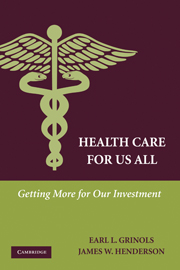Book contents
- Frontmatter
- Contents
- List of Tables
- List of Figures
- Preface
- Acknowledgments
- Executive Summary of the Targeted Intervention Plan
- PART I GOALS AND WORKING PRINCIPLES
- PART II BACKGROUND ECONOMICS AND ETHICS
- PART III APPLICATION
- 6 Why Government in Health Care?
- 7 Insurance
- 8 The Targeted Intervention Plan
- PART IV PROTECTIVE MEASURES
- A Top Ten Goals for the American Health Care System
- B Badly Done Insurance Programs Can be Worse Than No Insurance
- C Incentive Symmetry and Intervention Principle
- D Plan Workability
- E Market Power Response to Insurance
- Glossary and Definitions
- References
- Index
8 - The Targeted Intervention Plan
Published online by Cambridge University Press: 05 June 2012
- Frontmatter
- Contents
- List of Tables
- List of Figures
- Preface
- Acknowledgments
- Executive Summary of the Targeted Intervention Plan
- PART I GOALS AND WORKING PRINCIPLES
- PART II BACKGROUND ECONOMICS AND ETHICS
- PART III APPLICATION
- 6 Why Government in Health Care?
- 7 Insurance
- 8 The Targeted Intervention Plan
- PART IV PROTECTIVE MEASURES
- A Top Ten Goals for the American Health Care System
- B Badly Done Insurance Programs Can be Worse Than No Insurance
- C Incentive Symmetry and Intervention Principle
- D Plan Workability
- E Market Power Response to Insurance
- Glossary and Definitions
- References
- Index
Summary
The best ideas are common property.
Seneca, Epistles (5 B.C.–65 A.D)Society is always taken by surprise at any new example of common sense.
Ralph Waldo Emerson (1803–1882)Summary: Working from the list of attributes that Americans want and applying efficiency principles generates a virtually unique health care framework that resembles a free market except for those few particulars that need to deviate to accomplish the objective that everyone has health insurance. We call it the Targeted Intervention Plan.
Earlier chapters followed a demanding solutions-based, patient-focused agenda. A solutions-based, patient-focused agenda is justified, however, because we are dealing with health and welfare. To review:
Good health insurance needs to satisfy the four Ps: patient-centered, personal, portable, and permanent.
The arrangements we choose must provide access for anyone for insurable services on the same terms as everyone else. Those who may be receiving program help should not be identified or disadvantaged by this fact.
Available choices must respect incentives for high-quality provision of care. Market forces, including in the insurance market, are the guardians of patient interests, needs, and freedom.
Health care arrangements must be sound, providing assured cost containment features for government and program flexibility. The program should benefit from the economic insights and efficiency principles of Chapter 3.
Above all, health care arrangements must be sustainable – capable of thriving in perpetuity. Thus they must avoid inducements to polittroughing, governmentalizing, and Ponzi schemes. (See Chapter 3, Section 3.4, 3.5, 3.6, respectively, for technical meanings of these terms as used here.)
- Type
- Chapter
- Information
- Health Care for Us AllGetting More for Our Investment, pp. 130 - 164Publisher: Cambridge University PressPrint publication year: 2009

